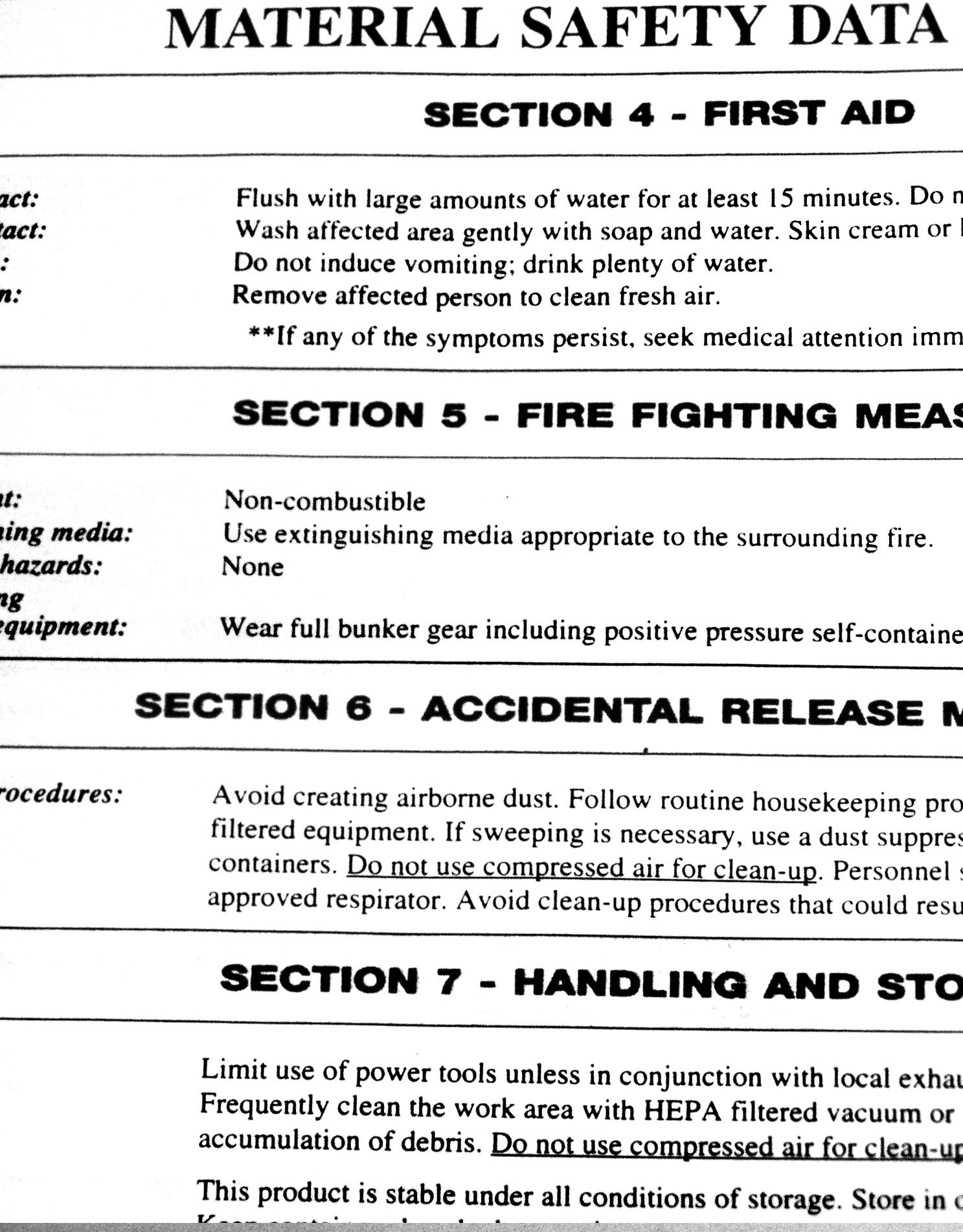Material safety data sheet

Overview
A material safety data sheet (MSDS) is a form containing data regarding the properties of a particular substance. An important component of product stewardship and workplace safety, it is intended to provide workers and emergency personnel with procedures for handling or working with that substance in a safe manner, and includes information such as physical data (melting point, boiling point, flash point, etc.), toxicity, health effects, first aid, reactivity, storage, disposal, protective equipment, and spill handling procedures. The exact format of an MSDS can vary from source to source.
MSDS (Material Safety Data Sheets) are a widely used system for cataloging information on chemicals, chemical compounds, and chemical mixtures. MSDS information may include instructions for the safe use and potential hazards associated with a particular material or product. MSDS can be found anywhere chemicals are being used.
There is also a duty to properly label substances on the basis of physico-chemical, health and/or environmental risk. Labels include hazard symbols such as the Saint Andrew's Cross (a black diagonal cross on an orange background which is used in the European Union to denote a harmful or irritant substance).
An MSDS for a substance is not primarily intended for use by the general consumer, focusing instead on the hazards of working with the material in an occupational setting. For example, an MSDS for a cleaning solution is not highly pertinent to someone who uses a can of the cleaner once a year, but is extremely important to someone who does this in a confined space for 40 hours a week.
In some jurisdictions, the MSDS is required to state the chemical's risks, safety and impact on the environment.
Usage by country
In the U.S., the Occupational Safety and Health Administration requires that MSDS be available to employees for potentially harmful substances handled in the workplace under the Hazard Communication regulation. The MSDS is also required to be made available to local fire departments and local and state emergency planning officials under Section 311 of the Emergency Planning and Community Right-to-Know Act.
In Canada, the program known as the Workplace Hazardous Materials Information System (WHMIS) establishes the requirements for MSDSs in workplaces and is administered federally by Health Canada under the Hazardous Products Act, Part II and the Controlled Products Regulations. WHMIS and MSDS requirements are also enforced by provincial Ministries or Departments of Labour.
In the U.K., the Chemicals (Hazard Information and Packaging for Supply) Regulations 2002 - known as CHIP Regulations - impose duties upon suppliers, and importers into the EU, of hazardous materials. The Control of Substances Hazardous to Health (COSHH) Regulations govern the use of hazardous substances in the workplace in the UK and specifically require an assessment of the use of a substance. Regulation 12 requires that an employer provides employees with information, instruction and training for people exposed to hazardous substances. This duty would be very nearly impossible without the data sheet as a starting point. It is important for employers therefore to insist on receiving a data sheet from a supplier of a substance.
Phrases
The European Union (EU) requires that Risk and Safety Statements ( R- and S-phrases) and a symbol appear on each label and safety data sheet for hazardous chemicals.
- R-phrases consist of the letter R followed by a number. See List of R-phrases.
- S-phrases consist of the letter S followed by a number. See List of S-phrases.
Water hazard classes
The German Federal Water Management Act requires that substances be evaluated for negative influence on the physical, chemical or biological characteristics of water. These are classified into numeric water hazard classes (WGK or WHC depending whether you use the German or English acronym).
- WGK nwg: Non-water polluting substance
- WGK 1: Slightly water polluting substance
- WGK 2: Water polluting substance
- WGK 3: Highly water polluting substance
MSDS authoring
Many companies offer the service of collecting, or writing and revising, data sheets to ensure they are up to date and available for their subscribers or users. [1] Some jurisdictions impose an explicit duty of care that each MSDS be regularly updated (usually every three to five years).
See also
- International Chemical Safety Card
- Risk and Safety Statements
- US Occupational Safety and Health Administration
- European Agency for Safety and Health at Work
- UK Health and Safety Executive
- LOLI Database
References
External links
- MSDS Solutions : An Online Searchable MSDS Database
- MSDS Authoring
- MSDS Compliance By Jurisdiction
- Where to find MSDS on the Internet (very extensive, ILPI)
- The MSDS FAQ (ILPI)
- ESPI has MSDSs for many metals & their compounds
- The MSDS HyperGlossary (ILPI)
- Short-form MSDS data (Oxford University)
- SIRI MSDS Index
- MSDS Authoring FAQ (Nexreg Compliance)
- US National Institutes of Health Household Products Database, including MSDS
- MSDS and Hazard Information Online and available on CD/DVD Set
- MSDSonline.com, Searchable MSDS Database
- Humorous MSDS for Dihydrogen Oxide (water).
de:Sicherheitsdatenblatt gl:MSDS he:גיליון בטיחות חומרים nl:Veiligheidsinformatieblad fi:Käyttöturvallisuustiedote